| Main page » Polish armour » armoured cars » wz.28 – Polish artillery – Steel Panthers – what's new |  | ||
| © Michal Derela, 2000 | Updated: 20. 8. 2024 | ||
| Main page » Polish armour » armoured cars » wz.28 – Polish artillery – Steel Panthers – what's new |  | ||
| © Michal Derela, 2000 | Updated: 20. 8. 2024 | ||
|
 | ||||||||
| A gun-armed wz.28 car, with early markings, refitted with pneumatic tires (a shape above a cupola seems a signal flag). |
Armoured car wz. 28 – a basic armoured car in Polish units in early 1930s, was one of only few halftrack armoured car designs in the world. More unique was, that these cars were next converted to full-wheeled drive. Though their service in original shape was short, but this design proved significant for the Polish armour – after conversion to wz. 34 model, in spite of shortcomings, they constituted a majority of Polish armoured cars available in 1939 September Campaign. Apart from these, three wz. 28 cars survived to take part in the campaign in their original shape.
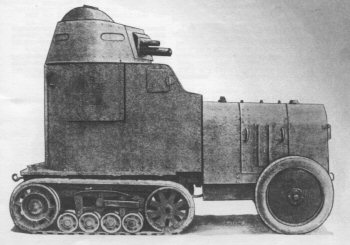 |
|---|
| French armoured car Citroën-Kegresse AMC M23: above - prototype [3], below - production car [4] |
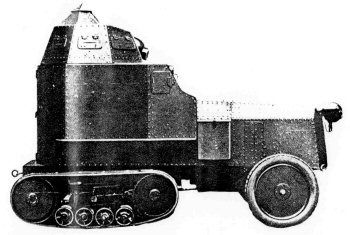 |
Armoured car wz. 28 (wzór 28) was designed in Poland upon the French halftrack chassis Citroën-Kegresse B2 10CV with Kegresse P4T tracked mechanism. A constructor of the chassis, Adolphe Kegresse was one of the pioneers of a halftrack drive in the world, and the most successful one. Since 1909, being the chief of Russian Tsar's garages, he has been working on the halftrack mechanism for cars (one of his early designs was used in armoured car Austin-Kegresse). After the Bolshevik Revolution in 1917 he left back for France, and than he developed a long series of halftrack cars there.
The first French project of Kegresse was a halftrack mechanism with rubber tracks for a touring car Citroën B2 10CV of 1921, made famous for cross-Sahara desert rally in 1922/23. Of course, first of all, halftrack vehicles became a subject of the Army's interest. The most popular Kegresse designs used in the French Army were halftrack artillery tractors (among others Citroën-Kegresse P14) and 'cavalry cars' (among others Citroën-Kegresse P19), but just in 1922 one armoured car Peugeot was experimentally fitted with a halftrack mechanism as well. In following years, several halftrack armoured cars were designed in France. In 1923 a prototype of armoured car Citroën-Kegresse AMC M23 was built, basing upon Citroën B2 10CV chassis, with Kegresse P4 tracked mechanism and a body made by Schneider. Two years later, a short series of 16 M23 cars, differing from the prototype, were built for the French cavalry. They were armed with one 37mm SA-18 Puteaux gun or a MG. Some served in Syria and Lebanon until 1941.
In 1928, 4 somewhat larger experimental armoured cars AMC M28 were built, with two weapons placed in opposite sides of a turret, and newer Kegresse P16 tracked mechanism. Finally, 96 improved half-track armoured cars AMC M29 were built by Schneider in 1929-1930. They had Panhard 15CV engine, so they were also known as AMC Panhard-Schneider-Kegresse P16. They were armed with a 37mm SA-18 gun and a coaxial MG in a turret. These cars served in some motorized infantry reconnaissance units (GRDIm) in 1940, but were not too popular. According to some sources, in 1933-35 another 12 improved vehicles with Hotchkiss 20CV engine were built. Also 6 halftrack armoured cars Citroën-Kegresse of not known model were used in the army of one of the Chinese warlords, Wu P'ei-fu.
 |
|---|
| Armoured car wz.28 with a basic older body type. [5] |
 |
| The first car wz.28 with a new body type, nr. 5294 [1,3] |
The Polish Army observed French experiences with interest. The halftrack seemed a perfect solution for poor country roads, which were numerous at that time, especially in eastern Poland (current western territories of Ukraine and Belorussia). Therefore, a special committee was sent to France to test new halftracks.
The committee, however, had some reservations about early French half-track armoured cars' designs. Therefore, Polish government decided to buy chassis only, and design own armoured car upon them. As a result, 135 half-track chassis Citroën-Kegresse B2 10CV were bought, starting from 1924. It was decided to use 90 for armoured cars; the remaining ones were to be built as trucks or special cars.
An armoured body was designed and manufactured in Poland, roughly patterned on the French AMC M23 production cars, but of simpler shape. An armament was the same: single 37 mm Puteaux low-velocity cannon or a machine gun in a turret. The main designer was Robert Gabeau of the Wojskowy Instytut Badań Inżynierii (Military Engineers' Research Institute) construction bureau, with Józef Chaciński of the CWS workshops. Two prototype vehicles were built in 1925. There is no such mention in publications, but newly found photos indicate, that one prototype had different, rejected type of armoured body and cylindrical turret (see below). Prototype cars were next evaluated in numerous exercises in the Central Cavalry School. As a result, one of these was accepted for production.
First 20 production cars were completed in 1927, and then assigned for further trials. In 1928 the design was accepted by the Army under a designation: armoured car wzór 28 (wz. 28) - 1928 Pattern. They were commonly called Citroën-Kegresse (CK in short), or just Citroën in Poland. All vehicles were completed in the CWS (Centralne Warsztaty Samochodowe - Central Car Workshops) in Warsaw, armoured plates were delivered by Bismarck Steelworks in Hajduki Wielkie (now Chorzów)[1]. In late 1929, an improved narrower hull was developed, with a sloped rear plate and different proportions, and last 15 cars were manufactured with a new hull, in July-August 1930. By 1930, all 90 cars wz.28 were manufactured, 1/3 of them cannon-armed.
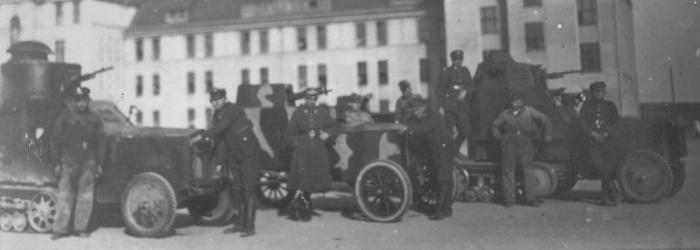 | The cars of a training platoon in Central Cavalry School, about 1925, showing most likely both prototypes of armoured car wz.28. The car on the right is the accepted variant, while the car on the left is apparently an alternative rejected model, described for the first time on our page. Note, that it also has an older chassis type (P4?). Between them - armoured car Ford Tf-c (FT-B) (noteworthy is its small size). [Photo courtesy of Julian Skelnik, from his collection] |
After first years of service, it showed, that the halftrack drive did not fulfil the expectations. A maximum speed was low - no more, than 30 km/h (18.5 mph) on road. The halftrack drive needed much maintenance, and rubber tracks had low durability. Off-road capabilities were not outstanding at all, and did not compensate for drawbacks. High center of gravity and small width increased a danger of overturning on transverse slopes. Because of these facts, in 1933 it was decided to convert the cars into fully wheeled vehicles, replacing the tracked mechanism with a rear driven axle. The first car (nr. 5423) was modified this way in 1934, and its tests came out well. It did worse off-road, but was much more practical on roads. It was next standardized with an Army designation: armoured car wz. 34, becoming Polish basic armoured car in 1939.
 |  |
| Left: the wz.28 car of the first series, wearing a barely visible early four-colour camouflage. Turret has 7 observation hatches, indicating the earliest production batch. The car has a 'sharp' nose. Two last digits of vehicle's number are retouched. [1,3] Right: the first car wz. 28 with a new body type - nr. 5294. Note chevron tracks and massive tires. [3] | |
It might be noted, that apart from Polish cars wz. 28 and mentioned French armoured cars (AMC M23 and M29 P16), the only serial half-track armoured cars were the Soviet Austin-Kegresse of 1919 and the German SdKfz.250/9 of 1942.
 |
| The cars wz.28, probably painted in uniform green colour. |
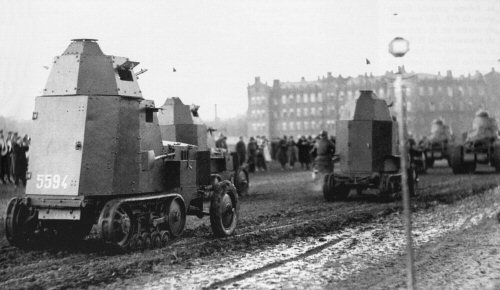 |
| The cars wz.28 on parade in Warsaw, 11 November 1930. The closest car has newer hull. Noteworthy are rare Renault M.26/27 tanks, also with Kegresse tracks, in a background. A location is misidentified as Grudziadz in books. |
The first two prototype cars wz.28 were tested in manoeuvres in Volyn in August 1925. From 1927 there started deliveries of production vehicles, supplementing and replacing armoured cars Peugeot in armoured units. The Polish armoured units underwent several reorganizations in that period. Among others, in 1928-1930 there existed 5 independent armoured car squadrons in cavalry divisions. From 1930 there existed two armoured car detachments (dywizjon, nos. 1, then 4, and 2), in 1933 renamed to the 2nd and 4th battalions. They were also used in a training centre in Modlin. From 1934, wz.28 cars were also used in the Independent Armoured Car Company in Bydgoszcz. At last, on 26 February 1935 there were created several armoured battalions, which were big, peacetime units of a mixed composition, including also tanks.
By 1931, the Polish Army received all 90 armoured cars wz.28. Thirty of them were used for training, while 60 were in a mobilization reserve. In first five months of 1931, 18 cars supported the Police in supressing communist-inspired riots in Malopolska province. It was next offered to sell these cars to the Police, but the price was considered too high.
Between 1934 and 1938, armoured cars wz.28 were being successively converted to wz.34 cars in units' workshops. Unfortunately, a number of converted cars is not sure - there were converted at least 80, probably 87 cars.
According to the source [2], in 1939 there still was one car wz.28 in the 4th armoured battalion in Brzesc upon the Bug, used for training. Also three (or two) vehicles were left for teaching in the CWBrPanc (Armoured Weapons' Training Centre) in Modlin. It may be assumed, that these cars were MG-armed.
After the World War II broke out, in September 1939, the three remaining cars wz.28 were included into the Armoured Weapons' Reserve Centre Nr.2 (Ośrodek Zapasowy Broni Pancernych), and formed an improvised troop, commanded by Lt. Feliks Uścinski. They were lost on a withdrawal track - the last one was destroyed by the Ukrainian nationalist saboteurs on 19 (?) September, when the Polish column was breaking towards Hungarian border.
Some sources claim, that instead of being converted to wz.34 cars, four armoured bodies of wz.28 cars were mounted upon boat hulls, creating armoured river liaison boats KM 12 - KM 15, with a propeller driven directly by a shaft from the engine. However, a photo of two KM boats does not confirm it, and it is doubtful comparing numbers of wz.28 and wz.34 vehicles. Such conversion was probably considered, for there exists such sketch, but not proceeded with.
| Wz.28 cars of the 5th Squadron, 2nd Armoured Car Detachment on parade in Kraków, 1933. A model with an old hull and a blunt nose is well visible. (click to see a whole scene) | 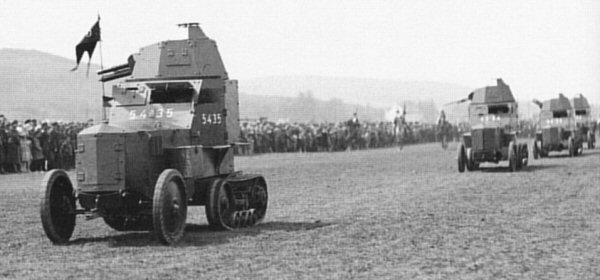 |
| Right: a squadron of the cars wz.28. Note a mixed armament and different front parts. Below: wz.28 cars' platoon of the 1st Armoured Car Detachment in Brześć, 1930 or 1933. The first car (no.5421) has 37mm gun, the rest (nos. 5253 and 5282) have machine guns. Behind them - armoured cars Peugeot. A leading staff car is Citroën-Kegresse B2 10CV. |
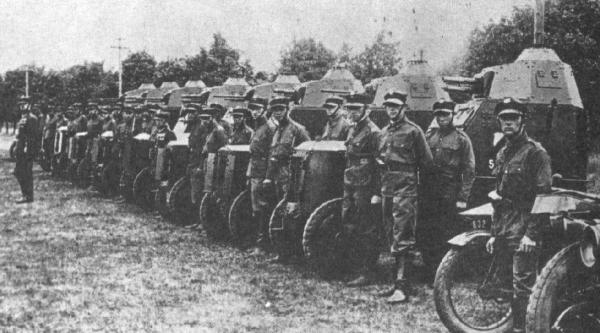 |
 | |
Technical description |  | |
| Armoured car wz. 28, showing its climb abilities. The nationality mark at that time was the white and red shield with slanted division line, on the side, above the vehicle number. The car has also a small white and red flag on the hood. [1] |
||
Armament and armour: | ||
 |
| Above: early wz.28 car, with older body and 7 hatches in turret sides. On a plate before a driver there is CWS badge. [1, 5] |
![Production variants of armoured car wz.28 [source 2]](wz28.gif) |
Approximately 30 cars wz.28 were armed with 37 mm SA-18 Puteaux L/21 low-velocity cannons with 96 rounds. It was a WWI-vintage weapon, fit best to fighting the machinegun emplacements and infantry, but it could also destroy light armoured vehicles at close range. It had a telescopic sight with 1.5x zoom. Maximum rate of fire was 10 per minute. It fired HE and AT rounds.
The rest of cars (about 60) were armed with one machine gun 7.92mm Hotchkiss wz.25 with 2000 (other source 4200)22:24 2013-10-21 rounds in 252-round belts. Both weapons were mounted in similar, rectangular Cardan mounts. Usually cars with cannons were the squadron or troop leaders'.
Armour - riveted of rolled steel plates, 3 - 8 mm thick (vertical plates - 8 mm, sloped plates - 6 mm), the bottom was not armoured - made of wooden planks.
The armoured body existed in two main variants. It was riveted and bolted of armoured plates, on a frame. In front there was an engine compartment, behind it a combat compartment, with a turret above. An access door was on the left side, opening backwards, and there was also a door in a rear plate, opening to
the left. Before the driver there were one or two small windows. Two smaller
vision ports were in the left door and right side. All windows were protected with flaps with simple vision
slots. A radiator in front, before the engine, was protected with a two-leaf hatch, opening from the driver's place. The engine hood was openable for servicing.
The earlier, most common variant of the body had a vertical rear plate, and the crew compartment widened into two sponsons over the tracks. There were two windows before the driver in this variant. The turret was moved rearwards, in relation to the combat compartment. In a rear part, the body was shorter, than a frame, which created a step. Photographs indicate, that these vehicles were built in several series, differing in details, especially a shape of the radiator cover. Part of cars had a blunt nose, with a fixed part above the radiator, part had a sharper nose, with a full-length bonnet (apparently such 'sharp' nose existed in early cars, and also last ones, with newer hull). The earliest production cars had 7 observational hatches in the turret's sides, the rest had only two. It should be noted, that body differences have been rather neglected in publications so far, and there are no reliable plans of these vehicles. Some conclusions must be drawn from photographs only. Also, the publications do not mention the early unaccepted prototype, shown on the photos on our page.
The newer version of the body had a sloped rear plate and narrow hull (the turret was slightly wider, than the hull). This version had only one window before the driver. Proportions of the car were changed, comparing with the earlier variant, because the whole armoured body seemes to be shifted rearwards on the chassis, with an exception of the turret, which remained in a similar position above the chassis' bogie.
According to J. Magnuski, only 16 newest cars were made with new hulls
(numbers: 5294, 5449, 5572, 5573, 5579, 5580, 5584, 5586, 5589, 5591, 5594, 5596, 5599, 5628-30), and 9 of them were gun-armed[1] (more - on the wz.34 car page).
The turret was octagonal, with a small, hexagonal, opening two-part ventilation and signalling
cupola on the roof. In the sides there were two small windows with flaps, and some vision slots (the earliest cars had 7 windows). The turret was mounted on a roller bearing, and turned manually.
According to publications, the crew was three (probably a driver, a commander and a gunner). During march the gunner was sitting on a small bench on the left side of the crew compartment, in combat he was in the turret, sitting on a belt, fixed between the walls of the crew compartment (similar belt was used as the driver's backrest). Note, that car wz.34 had only two-man crew.
The car was not equipped with a radio. The commanding was carried out with the color flags. A single removable headlight was on the left side, before the driver's window (they differed on some cars).
Chassis: a rectangular frame. Front suspension was on leaf quarter-elliptic springs. Rear suspension was the track mechanism Kegresse P4T, with a sprocket wheel to the rear, an idler in the front, and four double small roadwheels on a bogie. Bogies were sprung with double semi-elliptic springs and were pivoted on a transversal axle. In front there were full-rubber tires 710x90 mm or 750x90 mm. Later the cars received pneumatic tires. The tracks were rubber, the width was 275 mm (10.8 in).
Engine - Citroën B-14: 20 HP per 2100 rpm; 1477 ccm (other source: 1452 ccm), 4-cylinder, 4-stroke, water-cooled.
Transmission: dry single-disc main clutch. Mechanical gearbox: 3 gears forward and 1 reverse, with a reducer, which was giving output of 6 gears forward and 2 reverse. The tracks were driven only. Mechanical drum brakes were on idler wheels, auxiliary brake on the main shaft. Steering was accomplished with the front wheels and braking one track.

Armoured cars wz.28 cars were initially painted in a low-contrast four-colour camouflage scheme, introduced in 1928. It consisted of irregular patches of dark green, dark brown, greyish sand and blue-gray. Only the colors were specified, shapes of patches could be different, but they were mostly vertical waves. Some vehicles were dark green only. A nationality mark at that time was the white and red shield with slant division line, painted on the side.
| The MG-armed car wz.28 of the 3rd Armoured Car Squadron. The vehicle's name is Poznań (in this unit, the MG-armed cars were named after cities, while the gun-armed ones had female names, like: Jaga). Note a flag on a hood, and something, what seems an arrow-style turn indicator. [1] |
In 1932 there was a new three-colour disruptive camouflage scheme introduced. The patches were separated with thin black stripes, and their shapes were more regular. Traditional publications quoted colors: dark green, dark brown and greyish sand as the lightest shade, but according to the newest research, basing on examination of tankettes' parts, it consisted of yellowish sand, olive green and light blue-gray as the lightest shade. It was popularly known in Poland as the "Japanese-style" camouflage (more on tankettes page).
The vehicles which survived until 1937, might have been repainted in a final standard three-colour camouflage of Polish vehicles (see: wz.34), although it is not sure, if anyone bothered with repainting training vehicles.
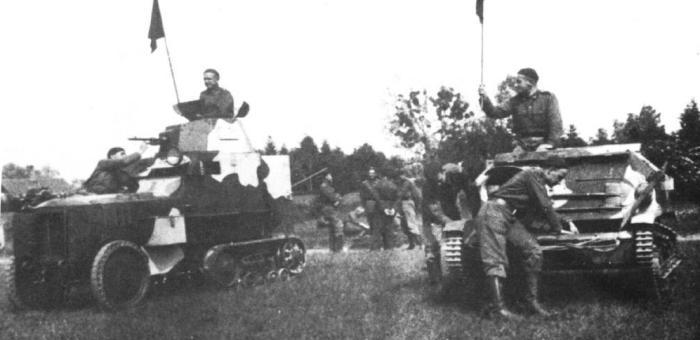 | The armoured car wz. 28 from CWBrPanc (Armoured Weapons' Training Centre) on a field training in Biedrusko (near Poznan) in August 1936. The car is wearing the "Japanese-style" camouflage pattern (used in 1932-1936). On the right - the tankette TK-3. [2] |
| Crew | 3 |
| Combat weight | about 2,300 kg |
| Length | 3.5 m (137.8 in) |
| Width | 1.4 m (55.1 in) |
| Height | 2.1 m (82.7 in) |
| Hull width (late / earlier) | 1.01 m / more (39.3 in / ) |
| Ground clearance | 280 mm (11 in) |
| Max. road speed | about 30 km/h (18.5 mph) (22-28 km/h - [1], 20-25 km/h - [3], 35-40 km/h - [2]) |
| Road range | about 200 km [2] or up to 275 km [3] |
| Max. steepness | 35o |
| Wading depth | 50 cm |
| Fuel tank capacity | 59 litres |
| Fuel consumption | 20-45 litres /100 km |
Miscellaneous photos of armoured cars wz.28:
| Armoured car wz.28 during a cross-country ride. Note movement of a suspension bogie. [5] | 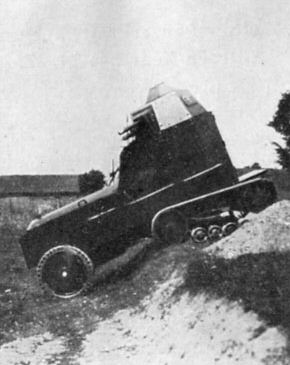 |
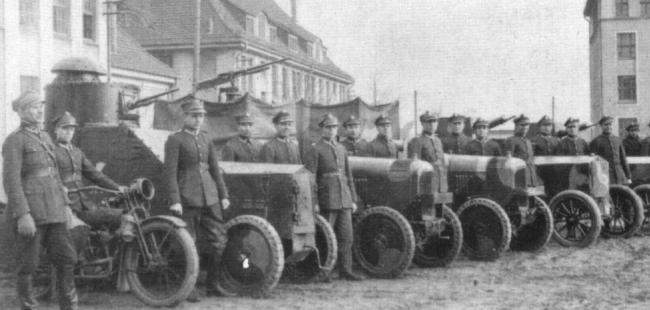 |
| A car platoon from the Cavalry Training Centre, 1926. On the left - most likely an alternative unaccepted prototype of armoured car wz.28. Next: two half-track cars Citroën-Kegresse B2 10CV (not armoured) and two light armoured cars Ford Tf-c (FT-B). A motorcycle is Harley-Davidson 1916 or 1917 with a sidecar. |
 |
| Armoured car wz.28 in the Police service, 1931? |
 |
| A commemorative shot with an overturned wz.28 car, on exercises. Note a pattern of rubber tracks and a pivot of suspension bogies. | 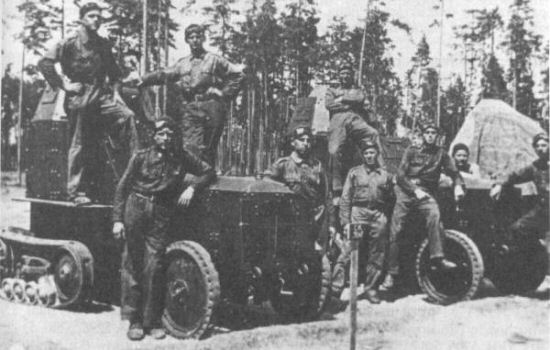 |
| The cars wz.28 of the 1st Armoured Car Unit in Brzesc on the Bug on a training ground Lesna near Baranowicze. [1] |
Models of a wz. 28 armoured car. Links from numbers lead to Scalemates.
1/72:
- Wild Hogs' Models (WH 72006) – Polish resin + metal model (2010), early hull, gun or MG-armed. Mediocre quality, out of production
1/35:
- F&A Miniatures (FA-35002) – new (2022) simple 3D resin kit. Late hull, machine gun.
Other:
- [1/48] F&A Miniatures (FA-48008) – new (2022) simple 3D resin kit. Late hull, machine gun.
- [1/100] Zebrano (ZBR-100069) – simple resin kit. New hull, cannon.
- [1/100] Zebrano (ZBR-100076) – simple resin kit. New hull, machine gun.
Sources:
1. Janusz Magnuski: Samochody pancerne Wojska Polskiego 1918-1939, Warsaw: WiS, 1993
2. Jan Tarczyński, K. Barbarski, A. Jońca: Pojazdy w Wojsku Polskim - Polish Army Vehicles - 1918-1939; Pruszków: Ajax, 1995.
3. Janusz Magnuski: Samochód pancerny wz.34, TBiU nr 56; Warsaw, 1979.
4. Pierre Touzin: Les véhicules blindés français, 1900-1944, Nancy: EPA, 1979
5. Heigl's Taschenbuch der Tanks, Munich, 1935
Update history:
Our thanks to Julian Skelnik and Jean-Guy Rathé.
Main page – Polish armour – Polish artillery – Steel Panthers
All photos and pictures remain the property of their owners, unless they are public domain due to age. They are published in non-commercial educational and research purpose.
Text copyright: Michal Derela © 2000-2024.